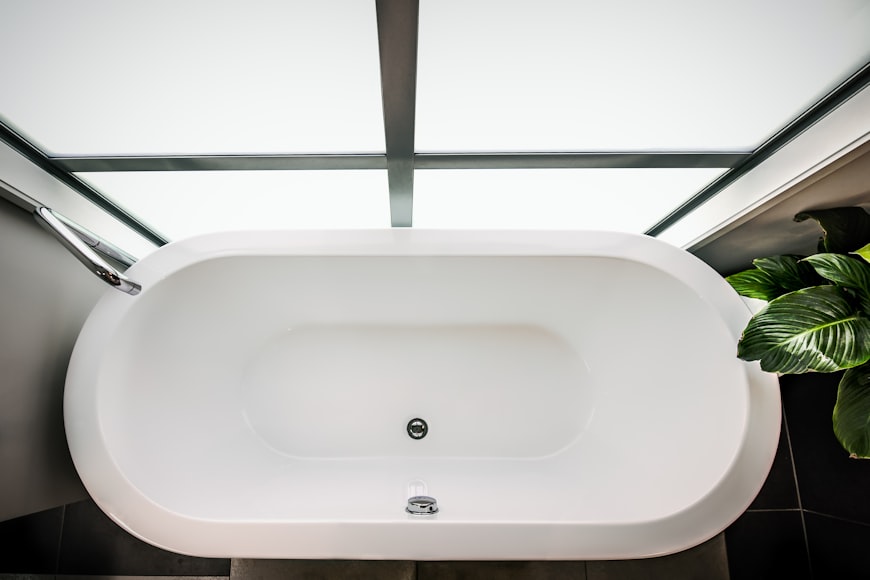How to remove your bathtub drain plug
Learning how to remove your drain will make repairing and cleaning your bathroom simpler. To do this, you must follow specific steps and use different tools to extract a bathtub drain properly. Our Allied Plumbing & Heating Supply Co. team has put together a list of how to identify the type of bathtub drain you have and the steps to remove your bathtub drain plug.
Flip-It Drain
A flip-it drain has a toggle that you can use by flipping to either side to open and close the drain, and it uses o-rings to keep it in place while you’re using it. To remove it, hold the outer chrome part of the drain gently but firmly on both sides, and rotate it while pulling upwards simultaneously. Twist the drain clockwise or counterclockwise. Additionally, you may wiggle the outer chrome body while pulling upwards to get it out.
Lift-and-Turn Drain
A lift-and-turn drain can appear similar to a push-pull drain because the stopper’s center knob opens and closes the drain by lifting and turning it slightly to open and close it. Opening and closing the drain requires you to turn it in opposing directions.
You’ll need Allen wrenches and a flathead screwdriver to remove this drain. Begin the removal process by ensuring the drain is open. Next, grasp the drain’s body, turn the knob slowly, and look for a screw on the knob. Once you locate the screws on the knob, use the screwdriver or wrench to loosen the screws. After loosening it, take the stopper of the drain’s post. If you can’t remove it, loosen the screws more.
Calcium buildup can prevent it from moving if you still can’t lift the stopper off the post. In this situation, exert more pressure to get it off or use the liquid wrench to do the heavy lifting. Once it’s removed from the post, unscrew the drain’s post from the strainer.
Alternatively, if your drain doesn’t have a screw on the knob, continue turning the knob counterclockwise until the stopper comes loose. From there, lift the stopper off. However, if the stopper doesn’t loosen from the strainer and there aren’t screws but proceeds to spin, the threads might be stripped. In this scenario, apply upward pressure while unscrewing the stopper. If this option doesn’t work, unfasten the bath waste flange from the drainpipe or call a plumber.
Plunger-Style Drain
A plunger-style drain can come in two variations — a trip lever or a turn style. With this type of drain, a plunger inside the drain blocks the water flow. Generally, these drains don’t have a stopper you can see from the outside, only a strainer over the drain.
Here are a few steps to remove a plunger-style drain with only a screwdriver. The first step is to locate the trip lever and unscrew the cover plate from the trip lever. You may find it easier to take out only one faceplate screw. Then, once you got one screw out, hold the faceplate in your hand securely while loosening the second screw. You will know the faceplate is loose when it swivels and lets it swing down. Here, you will put the first screw back in to avoid losing the piping in the back of the tub.
Then, remove the second screw as you grasp the faceplate. Pull out the trip lever out and away from the bathtub’s wall. If you need to, wiggle it free.
Pop-Up Drain
A pop-up drain can also have a trip lever or a turn style. In this drain, the trip lever or turn style moves the internal rod and rocker arm attached to the stopper against each other, which raises and lowers the drain. These drains have visible stoppers. Grab a bucket and a clean rag to remove this drain. First, flip the trip lever or rotate the faceplate, ensuring the drain is open. Most of these drains come out readily when you wiggle and pull straight out.
However, if your drain has the rocker arm, position the clean rag by the drain. This keeps the rocker arm from scratching your tub when you pull it out. Once you take the parts out, they can be messy with hair and soap. Use the bucket to place the pieces in.
PresFlo Drain
A PressFlo drain also uses an o-ring to make a seal, then spins the drain to open and close, using small amounts of pressure on the sides. To remove this drain, ensure the stopper is flat. Then, use the drain’s suction cup to apply pressure to the stopper. You may have to do this a few times. Next, grasp the suction cup firmly, pulling it out of the drain’s body. This may also take you a few tries to ensure the drain remains level.
Push-Pull Drain
The push-pull drain has a knob in its center of it. You push it down to close and pull it up to open the drain. You’ll need a flathead screwdriver, pliers, and a clean rag for the removal process. The drain can be opened or closed. First, extract the knob from the body’s center by holding the body and unscrewing the knob counterclockwise. Use the pliers and cover the knob with the clean rag to remove it if unscrewing doesn’t work.
Next, use the flathead screwdriver counterclockwise to loosen the brass post. Then, pick up the drain stopper off of the strainer.
Toe-Touch Drain
The toe-touch drain is simple. It has a stopper to open and close with your toe. To remove this drain, you’ll need a flathead screwdriver. The first step is ensuring the drain is open. Next, hold the stopper’s cylinder shaft to turn the top counterclockwise. If both the shaft and the top move, let go of the shaft and continue unscrewing. Once the shaft comes off the strainer, lift and pull it out.
Alternatively, if you unscrew the cylinder shaft and the top, only the top cap comes off. When only the top cap comes off, take it off. From there, unscrew the shaft in a counterclockwise motion and remove it from the stopper. Some cylinder shafts have screwdriver slots, which allow you to try a screwdriver to remove them.
So, there you have it, our team’s tips for identifying and removing different bathtub drain plugs. If you have questions, contact us. We can also help you find new drain plugs to replace your old ones when you visit our showroom in Chicago, Illinois.
Photo Credit: Image by Krystal Black is licensed with Unsplash License




